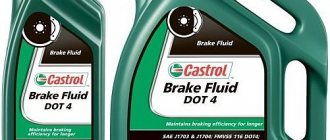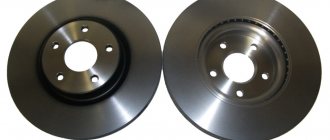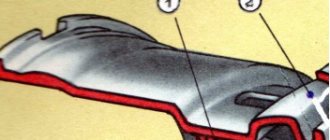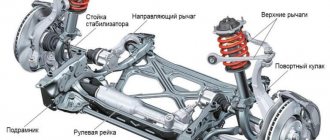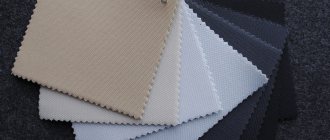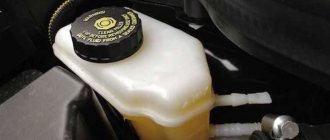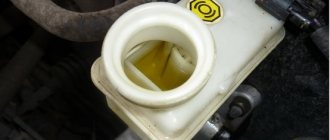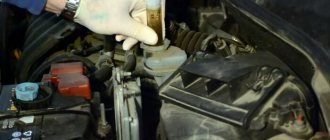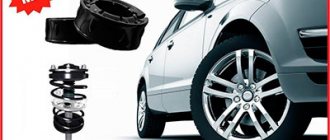Due to system leaks and brake malfunctions, car enthusiasts often have to add working fluid to the required level. The situation is aggravated when such things happen on the road - few drivers carry a reserve in the trunk for topping up. As a result, you need to buy and mix brake fluid from different brands and manufacturers to get it to the garage. This raises the question of the interchangeability of different compositions, which deserves detailed consideration.
What is brake fluid and what are its functions?
The brake fluid in a car transmits the pressure force from the main cylinder (brake master cylinder) to the brake mechanisms of each wheel.
The physical properties of liquids allow them to be used in closed circuits to instantly transfer force from one end of the line to the other. The car's braking system consists of:
- brake mechanism;
- brake drive (hydraulic, mechanical, electric, pneumatic and combined);
- pipeline.
Most often, budget and middle-class cars are equipped with a hydraulic brake system, the line of which is filled with TZ. Previously, butyl alcohol and castor oil were used for this. They were mixed in equal proportions.
Modern liquids consist of 93-98 percent ether polyglycols. To increase the efficiency and reliability of their products, manufacturers use various additives. Their number does not exceed 7%. Sometimes silicones are used as the basis for such substances.
Types of brake fluid
The industry produces three types of brake fluid:
- butyl (DOT 3);
- glycolic and polyglycolic (DOT 4);
- silicone (DOT 5).
Butyl brake fluid has a low boiling point and a high pour point, but it perfectly lubricates rubbing rubber parts without damaging them. This fluid is used only if it is recommended for the car. Glycol and polyglycol liquids boil at a temperature of 240-260 degrees, and begin to solidify only at a temperature of minus 40 degrees. In addition, they have good lubricating properties and are less aggressive towards rubber products (RTI): brake hoses and sealing rings. Silicone fluids have a high boiling point and a complete lack of hygroscopicity, but have a weak lubricating effect and destroy hoses and O-rings made of ordinary rubber. The numbers after the letters DOT indicate the approval class according to American safety standards (Department of Transport).
Why is it necessary?
Hydraulic brakes are very dependent on the fluid used. Its main task in such a system is to transmit force from the pressed handle to the pistons in the caliper through the master cylinder.
An important property of the “brake guard” is that it practically does not compress under load. Due to this, the composition does not absorb mechanical force, but transfers it to other elements. Additionally, the fluid must withstand high temperatures well, since natural heating occurs under the influence of friction during braking.
Basic properties
Brake fluids have a number of characteristics on which their performance directly depends. This:
- hygroscopicity;
- pour point;
- aggressiveness.
The ability of a liquid to absorb moisture depends on the level of hygroscopicity. The lower this figure, the better. This is due to the fact that moisture entering the brake fluid worsens its properties, in particular, lowers the boiling point.
The aggressiveness of the brake fluid determines the extent to which it has a negative effect on gaskets and other system elements made of rubber or plastic.
Pour point is an extremely important parameter. In severe frosts, brake fluid can become extremely thick and stop circulating in the system. In this case, it is difficult for the driver to press the brake pedal and may cause serious problems with driving safety. In Russia, which is famous throughout the world for its cold winters, it is necessary to use a liquid that retains its properties even at low temperatures.
Russian analogues
Let's look at the Russian analogues for Neva and Tom brakes, and whether they can be mixed with each other and with derivatives of the DOT classification:
- Neva, familiar to many, is produced on the basis of glycol with polyester. It also contains an anti-rust additive. However, the disadvantage is the rapid accumulation of water in it (hygroscopicity), which reduces its characteristics and requires more frequent replacements than others, is considered obsolete, and is gradually going out of production.
- Tom liquid contains glycol ether and a set of additives. Its performance is higher than that of Neva. In terms of quality and composition, it meets the DOT-3 class.
- The same base allows you to mix them with each other, replace the Neva with Tom. In addition, Tom can be mixed with other liquids of the dot-3 class and higher that have a glycol base.
- But can Neva be mixed with Dot 4? It is possible, this has been tested by experience and in practice by many motorists. Only this mixture, due to the fault of the Neva, requires more frequent changes, reducing the time by almost half. Agree, it will be cheaper to completely replace the Neva with a more reliable and long-term analogue.
Kinds
Brake fluids are divided into classes depending on their boiling point:
- Dot 3 – boiling point is 205°C, and the base is glycol ether.
- Class Dot 4 - the base is also a glycol ether, however, it contains an admixture of borate esters, which significantly affects the properties of the liquid, increasing the boiling point, which in the case of a pure liquid is 230 ° C.
- Dot 5 - has a high boiling point of 260 ° C, has greater compressibility than glycol ether based brake fluid.
- Dot 5.1 are liquids identical to class 4 liquids, but with the difference that silicone has been added to their composition. The boiling point is 260° C.
Glycol brake fluids are hygroscopic in nature, meaning they absorb moisture from the atmosphere over time. Silicon-based fluid is hydrophobic in nature, so it does not absorb moisture and provides a longer service life. All glycol-based fluids are compatible with each other and can be mixed. However, silicon-based brake fluid should not be mixed with any other type of brake fluid.
Which one to use?
Many car enthusiasts have a question about what fluid to use, especially those who recently bought a car and received a license. It is recommended to use the specification specified in the manual supplied with the machine. If you have lost your manual, it is now easy to look up the data online.
What should I do if I don’t have the fluid listed in the manual? There are such cases. You need to know which of them are compatible with each other. Let’s say you need DOT-3, you can safely add or replace it with the highest class 4 or 5.1, but only on the same base that allows mixing. Another option is to look at its analogs (ours or imported ones) on the Internet, or ask experts who have encountered this.
For example, using silicone brake fluids when you are prescribed glycolic brake fluids is suicide. Why can’t I use different brands of substances? It’s just that all rubber bands and mechanisms, cuffs, are designed for this type of chemicals; using a different type will cause destruction of the cuffs and seals, leakage and failure of the braking system.
Mixing brake fluid based on silicone and glycol is also prohibited; the difference in composition can cause coagulation and clogging of the system, and this also means brake failure. Serviceable brakes save lives, (and not only yours) remember this.
The use of a lower class of fuel fluid (the third pillbox instead of the fifth, for example), with a reduced boiling point is not desirable, because the calipers heat up, sometimes very much, and if the composition boils, the brake pedal will fail and the car will not stop in a timely manner.
Are pillbox substances from different manufacturers compatible? Yes, they are compatible, the fact is that the DOT marking means a production and composition standard. That is, in fact, manufacturers produce the same substances, according to the standard, provided that it is not a fake.
Master brake cylinder
The hydraulic brake system is equipped with a master cylinder. This part is installed on the vacuum brake booster. The GTZ of modern cars is two-section. In front-wheel drive and rear-wheel drive cars, the system operates according to different schemes.
- Front-wheel drive. Most often, such cars have two circuits: one connects the wheel brakes on the right side, and the other on the left side.
- Rear drive. One circuit connects the brakes of the rear wheels, and the other - the front ones.
Two sections of the GTZ and the presence of two different circuits were created for the sake of safety. If there is a leak of fuel fluid from one circuit, then the brake mechanisms of the other will operate. Of course, this will noticeably affect the movement of the brake pedal (the free play increases until the moment of response), but the brakes will not disappear completely.
The brake master cylinder includes:
- Frame. A tank with a reserve of fuel fluid is installed on top of it.
- Storage tank. It is made of transparent plastic, thanks to which you can control the liquid level without opening the lid. For convenience, a scale is applied to the walls of the tank, allowing you to monitor even minor volume losses.
- TJ level sensor. Located in the tank. When the level drops critically, a warning light on the instrument panel lights up (not all car models are equipped with such an alarm).
- Pistons. They are located inside the GTZ one after another according to the “train” principle. Both pistons are spring-loaded to automatically return to their original position after braking is completed.
- Vacuum booster rod. The first piston moves, then the forces are transferred to the second through a spring.
Requirements
For road safety, every car must be equipped with a reliable braking system. To fill it, you must use a liquid with a special composition. It must meet the requirements for:
- boiling point;
- viscosity;
- influence on rubber parts;
- influence on metals;
- lubricating properties;
- hygroscopicity.
Boiling temperature
When the brakes operate, the fluid filling the system becomes very hot. This occurs due to heat transfer from the brake discs and pads. Here are the average calculations of the temperature regime of the vehicle depending on driving conditions:
| Riding mode: | Heating the liquid to C |
| Route | 60-70 |
| City | 80-100 |
| Mountain road | 100-120 |
| Emergency braking (several presses in a row) | Up to 150 |
If the circuit is filled with ordinary water, then at this temperature it will quickly boil. The presence of air in the system is critical for proper operation of the brakes (the pedal will fail), therefore the composition of the fuel fluid must include substances that increase the boiling threshold.
The liquid itself is not liquefiable, due to which pressure from the pedal is accurately transferred to the brake mechanisms, but when it boils, small bubbles form in the circuit. They displace a certain amount of liquid back into the tank. When the driver presses the brake, the pressure in the circuit increases, the air in it is compressed, causing the brake mechanisms to not press the pads so tightly against the drum or disc.
Viscosity
Since the stability of the braking system depends on the fluidity of the substance, it must retain its properties not only when heated, but also at low temperatures. In winter, the braking system must operate with the same stability as in summer.
Thick fuel fluid is pumped through the system more slowly, which significantly increases the response time of the brake mechanisms. At the same time, it should not be allowed to be highly fluid, otherwise it threatens leaks at the junctions of the circuit elements.
Table of viscosity indicators of substances at a temperature of +40 toC:
| Standard: | Viscosity, mm2/s |
| SAE J 1703 | 1800 |
| ISO 4925 | 1500 |
| DOT3 | 1500 |
| DOT4 | 1800 |
| DOT4+ | 1200-1500 |
| DOT5.1 | 900 |
| DOT5 | 900 |
At sub-zero temperatures, this indicator should not exceed 1800 mm2/s.
Effect on rubber parts
During operation of the brake system, elastic seals must not lose their properties. Otherwise, rough cuffs will prevent the free movement of the pistons or leak the fuel fluid. In any case, the pressure in the circuit will not correspond to the required value, resulting in ineffective braking.
Effect on metals
Brake fluid must protect metal parts from oxidation. This can lead to damage to the mirror of the internal part of the brake cylinder, which will cause leakage of fluid from the working cavity between the piston collar and the wall of the brake center.
The resulting irregularities can lead to premature wear of the rubber elements. This problem contributes to the appearance of foreign particles in the line (pieces of rubber or broken rust), which will affect the efficiency of the hydraulic drive.
Additives overview
Brake fluid contains several additives. The main ones are discussed in the table below.
Table - Brief overview of the main brake fluid additives
AdditiveNote
| Dye | Helps determine brake fluid class |
| Anti-corrosion additive | Reduces damage to metal surfaces of the brake circuit |
| Antioxidant reagents | Inhibits the breakdown of constituent components and reduces the formation of acids and resins |
| Diphenylolpropane, bisphenol, triazole, azimidobenzene | Extends brake fluid service life |
Tips for choosing
To choose the right brake fluid for your car, you should pay attention to its physical parameters, which will prove its high quality. First of all, the concentration of the solvent is important. In a good liquid it should range between 70-80%. Another important factor is the concentration of the lubricant, which is usually 20-25%.
It is also worth paying attention to:
- heat resistance - the higher the boiling point of the liquid, the better;
- kinetic viscosity - determines the resistance to fluid flow in a hydraulic system;
- hygroscopicity - the ability to dissolve water molecules that can damage the brake system;
- inhibitor concentration is a group of additional substances that provide protection against corrosion and oxidation of the liquid.
How can you tell by color that brake fluid needs replacing?
There are several signs that, without special instruments, will indicate that the brake fluid is aging and losing its working properties.
- Darkening without loss of transparency. This color change is associated with the development of the base and additives, as well as with moisture saturation. If the liquid has only darkened, but has not lost some transparency, and there are no visible foreign inclusions in its volume, most likely it can still be used. You can find out more precisely only after analysis with a special device: a brake fluid tester, which will determine the percentage of water.
- Loss of transparency and the appearance of fine inclusions and heterogeneous sediments in the volume. This is a clear sign that the brake fluid has reached its limit and will have to be changed. Even if the tester shows that the moisture content is within normal limits, the fluid must be replaced. Otherwise, problems may appear in the system, since dark color and heterogeneous inclusions indicate wear of the additives.
Even if the brake fluid still seems normal in color, but its service life has exceeded 3 years for glycol bases and 5 years for silicone bases, it must be replaced in any case. During this period, even the highest quality options will become saturated with moisture and lose their lubricating and protective properties.
Classification of brake fluids for vehicles
Like any other technical fluids, brake fluid is produced in accordance with international and domestic standards. Today, most manufacturers adhere to two main standards:
— FMVSS Specification No. 116 — developed by the US Department of Transportation (USDOT). According to this specification, brake fluid is classified into classes from DOT-1 to DOT-5; — SAE J1703 and SAE J1704 specifications were developed by the Society of Automotive Engineers (SAE).
The American standard is most often taken as the basis; brake fluid according to SAE is much less common, so in the future we will consider the classification of brake fluid according to DOT. There are also liquids based on mineral oil, manufactured according to other standards, but they are practically not used in vehicles, and we will not consider them here.
The DOT standard provides for three groups of brake fluids:
- DOT-1, DOT-2 - are now practically out of use;
- DOT-3, DOT-4 - the most popular brake fluids based on polyethylene glycol;
- DOT-5 - silicone-based liquid;
- DOT-5.1 is a modified version of DOT-4 with improved characteristics.
It should be noted right away that DOT-5 and DOT-5.1 liquids, despite the similarity in labeling, have completely different compositions and characteristics, and it is unacceptable to fill one instead of the other. Each type of brake fluid is divided into two groups:
- For vehicles without ABS;
- For vehicles with ABS.
The purpose of the liquid must be indicated on its packaging, and there may also be an indication in the labeling, for example, DOT-4/ABS.
In Russia you can often find several other types of brake fluids - DOT-4.5, DOT-4+, DOT-4* and the like, however, there are no such classes in the original American standard, and most often this is a marketing ploy by manufacturers to attract additional profit.
How to check
There are special devices that measure the moisture content in brake fluid (moisture meters). The principle of operation is simple: to measure the amount of water, the device is immersed in the expansion tank. Colored indicators will indicate that the permissible limit has been exceeded.
True, the objectivity of such verification is conditional. Since brake fluid does not circulate through the system, its condition at the lower and upper levels may differ.
In the expansion tank, contact with air occurs more often than in other parts. But in the brake cylinders there is intense heating of the fluid and a change in its physical characteristics.
Replacing brake fluid
On cars without an anti-lock brake system and associated stabilization assistants, the user can change the fluid himself. To do this, you will need an assistant, or an adapter cap for the master cylinder reservoir. We pump the brakes from the far (rear right wheel) to the near (left front) until a uniform stream of light color appears.
Purchase the required amount of consumables in advance (usually the system capacity is about 1 liter), and also prepare tools - special keys for unscrewing the bleeder fittings, a plastic jar and a transparent tube. The use of open-end wrenches is highly undesirable due to the risk of damaging the edges.
In the case of a modern, complex ABS system, a diagnostic computer may be required to turn on the pump. In this case, you will have to use the services of a car service.
Applicability of brake fluids
Liquids have different characteristics, which determines their use.
DOT-3 is the cheapest and fairly versatile liquid. Most often used in early cars and trucks with drum brakes (and front disc brakes) that are not subject to too much use.
DOT-4 is a slightly more expensive, but most versatile brake fluid that is used in cars and trucks of almost any type and age with disc brakes. Due to its high viscosity, it works well in systems with a high degree of wear, providing negligible leaks.
DOT-5.1 is one of the most expensive and most demanding fluids. Due to its low viscosity, it is used on new cars; it is not recommended for use on cars with a worn brake system - in this case, significant leakage will occur. This fluid is also suitable for use in powerful high-speed cars, where high response speed of the braking system is important.
DOT-5 is the most expensive liquid and has limited applications. It is usually chosen for cars with low annual mileage, as well as for vehicles operated in conditions of very high (and even extreme) humidity. And DOT-5 fluids, due to the inability to absorb air and water (air bubbles and water droplets are formed), are not acceptable for use on vehicles with ABS.
How often should I change
Brake fluid is undoubtedly one of the most important fluids in a car. Its quality directly affects safety. According to recommendations, brake fluid should be changed every 40-50 thousand. km or every two years. This is also worth doing when there is a noticeable decrease in braking power. Brake fluid supports the operation of the hydraulic brake system. Therefore, it is necessary to maintain it in perfect condition to achieve the best braking performance.
The listed brake fluid is presented in different classes so that each reader can choose the best composition for their tasks. These products are the most reliable and high quality on the modern market.
What is the difference between DOT-3 and DOT-4 brake fluids?
Both brake fluids in question are made from the same base: glycols. Glycols are alcohols with two hydroxyl groups. This determines their high ability to mix with water without precipitation.
Let's look at the main operational differences in order.
- Boiling point. Perhaps, in terms of safety, this is the most significant indicator. You can often come across the following misconception online: brake fluid is not capable of boiling, since in principle there are no such hot heating sources in the system. And the discs and drums are located at a fairly large distance from the calipers and cylinders in order to transfer the temperature to the volume of the liquid. At the same time, they are also ventilated by passing air flows. In fact, heating is caused not only by external sources. During active braking, the brake fluid is compressed under enormous pressure. This factor also affects heating (an analogy can be drawn with the heating of volumetric hydraulics during intensive work). DOT-3 liquid has a boiling point at +205°C. DOT-4 has a slightly higher boiling point: +230°C. That is, DOT-4 is more resistant to heating.
- Drop in boiling point when humidified. DOT-3 liquid will boil after accumulating 3.5% moisture in volume at a temperature of +140°C. DOT-4 is more stable in this regard. And with the same amount of moisture it will boil no earlier than after passing the mark of +155°C
- Viscosity at –40°С. This indicator for all liquids is set by the current standard at a level not higher than 1800 cSt. Kinematic viscosity affects low-temperature properties. The thicker the liquid, the more difficult it is for the system to operate at subzero temperatures. DOT-3 has a low-temperature viscosity of 1500 cSt. DOT-4 liquid is thicker, and at –40°C it has a viscosity of about 1800 cSt.
It is noted that thanks to hydrophobic additives, DOT-4 liquid absorbs water from the environment more slowly, that is, it lasts somewhat longer.
Brake fluid compatibility
When replacing brake fluids, you should be aware of their compatibility. In general, you need to follow two recommendations:
- DOT-3, DOT-4 and DOT-5.1 fluids are compatible with each other;
- DOT-5 fluids are not compatible with any other fluids.
The first three liquids have a glycol base, and their additive composition is similar, so they are generally compatible. DOT-5 liquid has a silicone base, and when mixed with glycol liquids, complex chemical reactions occur, as a result of which the resulting mixture completely loses its qualities.
However, it is also better not to take risks with DOT-3, DOT-4 and DOT-5.1. Different manufacturers use different additive packages, which may conflict when mixed. Therefore, it is allowed to mix liquids of different types within the same brand.
Classification of liquids
To find a solution to the problem and figure out what compounds can be mixed in an automobile brake system, it is worth listing the existing brands of fluids:
- BSK;
- DOT 3, DOT 4, DOT 5.1;
- DOT 5, DOT 5.1/ABS.
In this list, various brands are grouped according to one characteristic - chemical composition. BSK - butyl-alcohol-castor mixture is an outdated material that was used in previous generations of cars and does not meet modern requirements. Found in older vehicles with low travel speeds.
DOT 3, 4 and 5.1 are different brake fluids of the same class with similar characteristics, made on a glycol basis. They differ in their boiling point, which plays an important role for modern cars. The higher the boiling point of the liquid medium in the system, the greater the loads the brakes can withstand without fail.
Reference. Glycol formulations are hygroscopic, that is, they absorb moisture from the air. After saturation above 3%, the material becomes unsuitable for further use and must be replaced (the latter is performed once every 2–3 years).
The boiling point of glycol-based formulations depends on the degree of moisture saturation. Below are the characteristics of brake fluids in “dry” and wet states:
- DOT 3 – 230 °С, humidified – 140 °С;
- DOT 4 – 240 / 155 °C;
- DOT 5.1 – 260 / 180 °C.
The next group of materials – DOT 5, DOT 5.1/ABS – are silicone with reduced hygroscopicity. The temperature ratings are identical to the DOT 5.1 brand, but the chemical base is different. Due to low water absorption, the liquid can last longer - up to 5 years without loss of performance properties. The downside is the insufficient degree of lubrication of the caliper parts (cuffs, pistons, rings), which is why the latter quickly become unusable.
How does DOT 5 differ from other options?
DOT 5 is a formulation that was supposed to be an improved solution. During its development, emphasis was placed on increasing the boiling point. It is important to note that DOT 5 is silicone based, so it is not compatible with other options.
The key advantage of DOT 5 is its hydrophobic properties. This composition does not absorb moisture from the atmosphere, and its boiling point does not decrease for a long time. This increases service intervals and ensures a long storage period.
What should I use instead of brake fluid?
It will not be possible to pour any liquid into the system. It’s all about the characteristics of the brake substance, so you need to select a fluid that is as close in properties as possible.
According to the rules for using brake fluid, mixing substances with different indicators or using other products is prohibited. However, in some cases, for example, when a fluid leak occurs and an emergency replacement cannot be made, the following can be used instead:
- soapy water;
- power steering or automatic transmission oil;
- regular motor oil;
- alcohol.
Soapy water
Regular water cannot be used. This will lead to an accelerated corrosion process. In addition, it evaporates at 100ºC, and the brakes constantly heat up. It is better to use soapy water. At the same time, a large amount of soap must be dissolved in it.
Adding soap reduces the hardness of the water and does not cause much harm to the brakes, so you can safely use this method to urgently get to the service station.
Power steering and automatic transmission oil
Power steering oil has characteristics similar to brake fluid. In an emergency, you can use it and get to the service center.
Engine oil
Its structure is very thick, so it needs to be diluted before use. Water should not be used to avoid corrosion. In this case, you can use diesel fuel.
Alcohol
Oddly enough, alcohol has very similar characteristics to brake fluid. In addition, it does not pose serious harm to the mechanisms.
Brake fluid markings
The brand and main characteristics of the brake fluid are indicated on the packaging, and the DOT type of fluid must be indicated in large print. Also, depending on its type, the liquid has a certain color:
- DOT-3, DOT-4 and DOT-5.1 - yellow (with gradations from light yellow to light brown);
- DOT-5 - pink/red;
Coloring allows you to immediately determine the type of liquid and prevents errors in selection or accidental mixing of different liquids.
